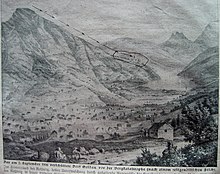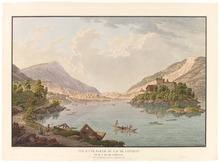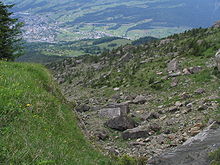Goldau landslide
The Goldau ( Schwyz ) landslide on September 2, 1806 was a natural disaster that affected Goldau and Lauerz in Switzerland .

Origin of the landslide
In addition to the build-up of the rocks, the removal of the supporting rock layers by glaciers and the softening of the load-bearing marl layers by penetrating water, a rainy period led to the formation of the landslide .
In the foothills of the Alps, layers of sediment were deposited around 25 million years ago, which solidified into hard rocks in the following time. In the last phase of the Alpine folding, these rocks became part of the mountain formation. The rock faces were inclined and raised to form molasse mountain ranges such as the Rigi and Rossberg .
During the Ice Ages , a branch of the Reuss Glacier widened the valley and removed the lower parts of the inclined rock layers. In the process, the higher layers lost the abutment of their supporting feet, so that they were only held on the slope by frictional forces.
Over time, formed in the rocks fissures through which the water could penetrate into the underlying layer of marl, which was so watered down more and more. The increasingly soft marl layer became a slide for the rock layers above and it only took a rainy period to trigger the landslide.
Warning notices
The landslide had already announced itself about 30 years earlier by characteristic signs such as increasing cracking on the mountain, rolling stones, cracking cracking of broken roots, formation of water-filled open crevices and thundering noises. Although everyone expected that the Rossberg would one day crash, only five people took the consequences and left the danger area. After the years of particularly high rainfall in 1799, 1804 and 1805 and a damp spring and August in 1806, the catastrophe finally occurred on September 2nd.
Course of the landslide
After the Basel earthquake, it was the biggest natural disaster in Switzerland to date. On the southern flank of the Rossberg in the canton of Schwyz , almost 40 million m³ of Nagelfluh rock from the Gnipenspitze set in motion on a slideway sloping around 20 ° over heavily moistened clayey intermediate layers at 5 p.m. and fell about 1000 meters into the valley within three minutes. The slide of the 0.5 km² large demolition area spread out in a fan shape at the bottom, surfaced 100 meters on the opposite Rigikette , covered an area of around 6.5 km² and destroyed the villages of Goldau , Röthen as well as parts of Buosingen and Lauerz . 457 people were killed, 323 head of cattle were killed, 111 houses, 220 stables and barns as well as two churches and two chapels were destroyed. 206 people had fled or were absent. The villages of Goldau and Röthen had disappeared and the Lauerzersee was reduced by a seventh of its area. Eyewitnesses reported that the landslide triggered a 20-meter high tidal wave.
follow
The landslide was used to mark the birth of the first Swiss fundraising and as an opportunity to strengthen national solidarity. For many people, the landslide was a demonstration of divine power. But it was also the first to be scientifically investigated and explained: The Rossberg was a landslide. Nagelfluhbänke slid on the underlying weathered and softened marl , which was turned into a slide by heavy rains.
The village of Goldau, which belongs to the political community of Arth SZ , was rebuilt on the rubble cone and grew into a transport hub. The nature and animal park Goldau , in the midst of huge boulders in the landslide area, is a popular destination. In the landslide area, a hiking trail leads through pioneer vegetation to the Rossberg (Gnipen). A plant protection area, supervised by members of the Pro Rossberg Foundation, is marked in a clearing in the landslide area. The occurrence of numerous types of orchids, especially the yellow lady's slipper, should also be emphasized .
First newspaper reports
The Neue Zürcher Zeitung reported on September 9, 1806:
«Schwyz, September 5th, 1806. September 2nd was a sad, deplorable day for the Schwyz district. After an extraordinarily heavy downpour of twenty-four hours, at 5 o'clock in the evening at the mountain Spitzebüol, above the village of Röthen, the uppermost rock peak broke out. At the same time, detached from the core of the mountain by subterranean water, an enormous mass of earth, 300 cubits deep and 100 feet wide, separated from the mountain. This terrible Errdlauwe, tore dwellings, people and cattle with it over the ridge of the mountain, and fell with indescribable force into the valley below. Throwing many centennial stones through the air to an unbelievable distance, the earth current, which was many yards high, drove with lightning speed over the one hour wide, fertile and flats-strewn plain to the Rigi mountain opposite, pushing the rubble several thousand feet up up the mountain, the thickest trees were shattered into splinters, devastating and overwhelming everything far around. A small part of the terrible mass, when it broke, had already taken a direction different from the main mass; this turned to the left, rolled upwards towards the Lauwerzer lake, drove him out of his bed, and forced the tide to jump 150 shoes high over it. The force of the water carried away all the buildings around the lake, destroyed the country road, and covered the lake with rubble and ruins. It buried this ghastly event in 5 minutes in one of the most usable and beautiful areas of the district from Lowerz to Ober-Art, an hour wide and an hour long. The most splendid meadow estates, four considerable towns, Lowerz, Busingen, Goldau and Röthen, innumerable scattered dwellings and farms, over 1000 people, and an unspeakable number of cattle are buried under many yards of high rubble. One no longer knows the place where this or that place stood, and across the middle of the devastated piece of land stands a completely new mountain of considerable height.
What is still unknown is the number of travelers who, at this unfortunate hour, wandered on the heavily frequented road, and who shared the terrible fate of the inhabitants. So in a period of eight years all possible tribulations over the poor Schwyz come together; and in one of its valleys, after 200 years, the mournful scene of Plurs had to be renewed, which on September 4th, 1618, met its downfall in a similar way. "
Media coverage
The Goldau landslide had a great echo in the emerging European press landscape at the beginning of the 19th century, which was promoted by the new reproduction possibilities of wood engraving . Thanks to Switzerland's image as a natural world, it met with great interest. As a diorama by Louis Daguerre , a multimedia processing of the landslide could be seen in many European cities: the mountain landscape before and after the disaster was shown on two painted sides of a stage prospect. The “lovely Swiss landscape” was able to turn into “devastation” through changing lighting. The controllability of nature through technology began to become realistic hope at that time. The media-technical repeatability of the catastrophe is still fascinating today.
Cultural adaptation
Fiction
- Werner Adams: The Milk Prince - The tragic journey of a group of Bernese aristocrats into the Goldau rockslide . Self-published, Schwyz 2020, ISBN 978-3-9524378-8-9 .
- Ernst Eschmann : The mountain is coming! A story of the Goldau landslide. F. Reinhardt, Basel, 1928, DNB 574711058 .
- Martin Ulrich: The Goldau landslide. Gotthard Media, Lauerz, 2020, ISBN 978-3-03806-051-2 .
Compositions
As early as December 1806, a cantata was published on the subject of the landslide. The music was composed presumably "Rector W. from the St. B." to a libretto by A. Hofmann. Esther Rickenbach lists a total of nine titles:
- A. von Hofmann ( St. Blasien Abbey ): Cantata. 1806.
- Joseph Weigl : The Rockslide: Opera in three acts. 1813.
- Hedwigis Mettler (Institute Menzingen) : The Rockslide of Goldau: Oratorio. 1928.
- Paul Hindermann: Song for male choir. op. 4. Verlag Rob. Forberg, Leipzig, 1899.
- Werner Peter: The landslide mass. 1953.
- Mani Planzer : rockslide song. after 1970.
- Peter Lüssi : Rockslide music for the commemoration on September 2, 2006.
- Peter Lüssi, Ruedi Schorno: rockslide musical for children's choir and band. 2006.
- David Haladjian : The Rockslide at Goldau: for mixed choir a capella. 2004.
literature
- Margrit Rosa Schmid: When mountains tumble into the valley: The Goldau landslide in 1806 (= SJW ; 2237). Schweizerisches Jugendschriftenwerk, Zrüich, 2006, ISBN 3-7269-0521-9 ; with 100 color illustrations.
- Neue Zürcher Zeitung, Aug. 30, 2006, No. 200, pp. 15, 57.
- Karl Zay : Goldau and its region, as it was and how it has become. 1807. Facsimile reprint: Cantina-Verlag, Goldau, 2006, ISBN 3-85600-039-3 .
- Louis Jacques Mandé Daguerre: The daguerreotype and the diorama or an exact and authentic description of my method and my apparatus for fixing the images of the camera obscura and the manner of painting and lighting used by me in the diorama. Metzler, Stuttgart, 1839. Reprint: Metzler, Stuttgart, 1989, ISBN 3-476-00683-2 , p. 60. Reprint also in Ed. Libri Rari in Verlage Schäfer, Hanover, 1988, ISBN 3-88746-211-4 .
- Beat Keller: Massive rock slope failure in Central Switzerland: history, geologic-geomorphological predisposition, types and triggers, and resulting risks. In: Landslides, 2017, 14/5, pp. 1633–1653, doi : 10.1007 / s10346-017-0803-1 .
- Markus Hürlimann: The Goldau rockslide 1806: History of the natural disaster and considerations 200 years later (= Schwyzer Hefte; 89). from the cultural commission of the canton of Schwyz. Publishers Schwyzer Hefte, Schwyz, 2006, ISBN 3-909102-51-4 .
- Josef Niklaus Zehnder: The Goldau landslide: its time and its precipitation. Bergsturzmuseum Foundation, Goldau, 3rd edition, 1988, DNB 946560056 .
Web links
- The Goldau landslide. In: arth.ch . April 23, 2019.
- Landslide museum. In: arth-online.ch.
- Landslide museum. In: museums.ch.
- Kurosch Thuro, Christoph Berner, Erik Eberhardt: The Goldau landslide in 1806 - failure mechanisms in alternating conglomerates and marls. (pdf; 972 kB) In: Publication from the 15th Engineering Geology Conference, 6. – 9. April 2005. Edited by Michael Moser. Friedrich-Alexander-Universität , Erlangen, May 28, 2005, pp. 303-308 (published on goldauerbergsturz.ch).
- André Goldmann: The Goldau landslide. (pdf; 383 kB) In: goldauerbergsturz.ch. August 12, 2006 .
- Patrick Kaufmann: Goldauer rockslide: 2 new eyewitness reports. In: Arth-online News. September 10, 2001, archived from the original on March 28, 2002 .
- David Bressan: The Goldau landslide. In: geschichtedergeologie.blogspot.com. September 7, 2012 .
Individual evidence
- ^ Thomas Reichlin, André Grundmann: Goldauer Bergsturz of 1806: The catastrophe was preprogrammed. In: goldauerbergsturz.ch. January 1, 2007, accessed April 26, 2019 .
- ^ A b Hans Georg Wunderlich: Introduction to Geology, Volume I, Exogenous Dynamics , Bibliographisches Institut Mannheim / Vienna / Zurich, BI-Wissenschaftsverlag, Mannheim, 1968, p. 69.
- ↑ Goldau landslide. In: arth-online.ch. Archived from the original on May 20, 2006 ; accessed on September 2, 2021 .
- ↑ Flyer of the landslide museum: The misfortune in numbers .
- ^ Esther Rickenbach: rockslide music. (pdf; 11.4 MB) In: Vox humana. 26, February 23, 2007, p. 4 , accessed September 2, 2021 .
- ^ Esther Rickenbach: rockslide music. (pdf; 11.4 MB) In: Vox humana. 26, February 23, 2007, pp. 4-7 , accessed September 2, 2021 .
-
^ Crash of the Bergsturz opera. In: Messenger of Urschweiz . August 13, 2009, accessed on September 2, 2021 (published on SchwyzKultur.ch). The catastrophe in three acts. In: NZZ.ch . August 27, 2006, accessed September 2, 2021 .
-
↑ Angelo Garovi: Music history of Switzerland. Stämpfli, Bern, 2015, ISBN 978-3-7272-1448-6 , pp. 99-102.
Jürg Meienberg: Book excerpt - Swiss composers in women's convents. In: kathbern.ch . October 14, 2015, accessed September 2, 2021 .
Coordinates: 47 ° 4 ′ 34 " N , 8 ° 33 ′ 43" E ; CH1903: 685 311 / 214510




